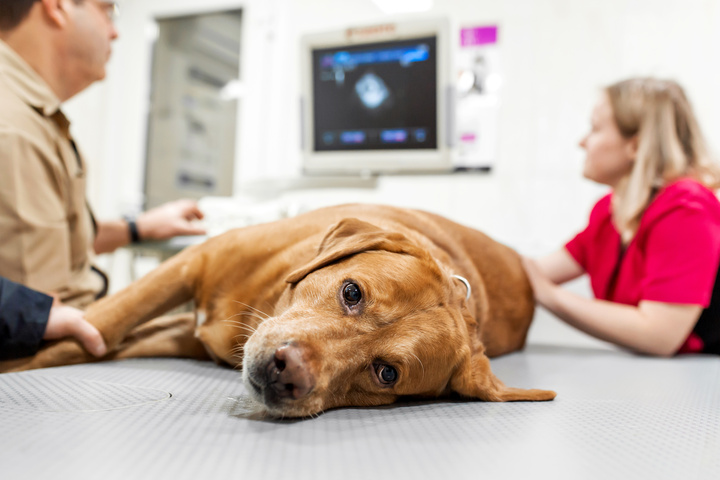A parasite known as Giardia duodenalis, Giardia lamblia, and Giardia intestinalis is responsible for giardiasis, an infection unaffectionately known as “Traveler’s Diarrhea.” This microscopic pest lurks worldwide in soil, food, water, and surfaces contaminated with infected human or animal feces.
Both humans and animals can become infected and experience various gastrointestinal symptoms ranging from mild to severe. The good news is that although an infection may be uncomfortable, it is treatable and generally not life-threatening.
The symptoms of giardiasis in dogs can vary, and some infected dogs may not show any signs, making diagnosis difficult. Dogs most vulnerable to infection are typically younger or older or have weakened immune systems.
What your dog’s poop can tell you about giardia infection
Spotting giardia in your dog’s poop is challenging because the parasite itself is not visible to the naked eye. However, some common signs may indicate the presence of giardia or other intestinal parasites.
Consistency. If you notice that your dog’s stool is consistently loose, watery, or contains mucus, it could be a sign of giardia or another gastrointestinal issue.
Color. While stool color can vary depending on diet and other factors, poop that is unusually pale or abnormally colored (such as black or bloody) could indicate a problem, including a giardia infection.
Presence of worms. While giardia is a single-celled parasite and not a worm, the presence of visible worms or segments of worms in your dog’s stool may indicate a parasitic infection that requires veterinary attention.
Frequency. If your canine companion suddenly has more frequent bowel movements or seems to be straining during defecation, it could be a sign of gastrointestinal distress, possibly due to giardia.
Odor. Changes in the odor of your dog’s stool, such as a foul or unusual smell, could indicate an underlying issue, including a giardia infection.
Other signs that your pup may have a giardia infection
Vomiting. Dogs with giardiasis may vomit, which, along with diarrhea, can lead to dehydration and weight loss.
Lethargy. Infected dogs may not have their usual spunk and vigor to play or exercise.
Dehydration. Diarrhea and vomiting can lead to dehydration, which may manifest as dry gums, decreased skin elasticity, and sunken eyes. It is important to watch for this.
Abdominal discomfort. Some dogs may exhibit signs of abdominal discomfort, such as abdominal pain, bloating, or discomfort when touched.
How is giardiasis diagnosed?
If you suspect your furry friend has giardiasis, visiting your veterinarian for an official diagnosis and treatment regimen is important. Giardia is typically diagnosed using clinical signs, fecal examination, and sometimes additional diagnostic tests.
The primary method for diagnosing giardia infection in dogs is through a microscopic examination of feces. A fresh fecal sample is examined under a microscope for giardia cysts or trophozoites (the active form of the parasite). However, because giardia shedding can be intermittent, multiple fecal samples may be necessary to increase the chances of detection.
In addition to direct microscopic examination, a fecal flotation test may be performed. This test involves mixing a fecal sample with a solution that causes parasite eggs, cysts, or oocysts (the infectious form of giardia) to float to the surface, where they can be examined under a microscope.
Fecal antigen test. Sometimes, a fecal antigen test may be used to diagnose giardia infection. This test detects specific proteins (antigens) from giardia in the dog’s feces. It can be more sensitive than microscopic examination alone and may be particularly useful in cases where giardia shedding is low.
Additional tests. Your veterinarian may recommend additional tests to rule out other gastrointestinal issues. These may include blood tests to assess for signs of inflammation or other abnormalities, imaging studies such as X-rays or ultrasound to evaluate the gastrointestinal tract, or endoscopy with biopsy to visualize and collect samples directly from the intestines.
Remedying giardia infection
Once a diagnosis of giardia is confirmed, your veterinarian will recommend an appropriate treatment plan tailored to your pup’s needs. This typically involves oral medications such as metronidazole or fenbendazole to eliminate the parasite.
Measures to prevent reinfection, such as cleaning and bathing, may be advised. Your veterinarian may also prescribe a light diet that supports digestive health until the infection is gone.
Can giardiasis be avoided?
As a pup parent, taking certain precautions can significantly reduce the risk that your dog will come in contact with the giardia parasite. Always practice good hygiene by cleaning up dog poop in your yard, at the dog park, or in other common areas. Ensure that your dog always has access to clean and fresh water. Don’t let your pooch drink from unknown water sources, especially stagnant ponds or puddles. Regularly bathe your furry friend and wash and disinfect bedding and toys. Feed your dog a balanced, whole-food diet that will help to keep the immune system robust.






